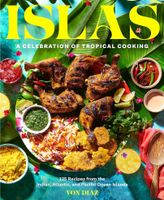Advertisement
Steaming with Banana Leaves
There were too many variations across recipes in this chapter to provide meaningful instruction in other areas, so I’ve chosen to focus on steaming with banana leaves. Like coconuts and rice, banana leaves unite the tropics. Even though we think of them as trees, bananas and plantains are herbaceous plants, rhizomes that spring up from a network of interlocking roots. The fruit they produce is abundant and can be enjoyed in all stages of ripeness, and their leaves are an incredibly versatile tool. They provide a buffer to protect food from direct heat, a package within which food can be roasted or steamed, all the while perfuming food with an unmistakable earthy, slightly sweet, grassy aroma and flavor. Fresh, clean leaves can be used to handle food, as serving dishes, and as the centerpieces for celebratory meals such as a Filipino kamayan buffet, where whole roast suckling pig, rice, vegetables, pickles, and sauces are set across a long leaf-covered surface and piled high. And because these plants dot the landscape, cooking with banana leaves ties body to earth in a special, visceral way.

